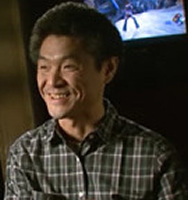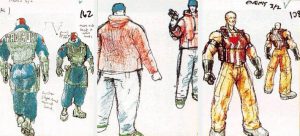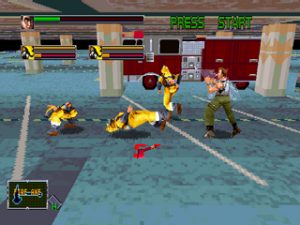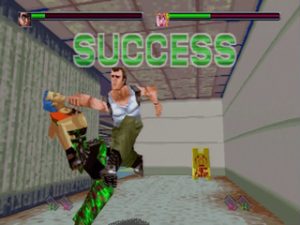 The following two interviews were originally published in the October/November 1997 issue of Sega Saturn Magazine and on Sega’s website circa 1997. The first part was translated by the author as research material for the Die Hard Arcade section of the book The Sega Arcade Revolution: A History in 62 Games. AM1 Designer and Director Makoto Uchida already had a storied history at Sega, having created the arcade classics Altered Beast, Golden Axe, and Alien Storm. With Die Hard Arcade, he would lead the development of the most successful U.S.-made arcade video game in Sega’s history These interviews contain some interesting information regarding what would become Sega’s most successful American-developed arcade game and a Saturn classic.
The following two interviews were originally published in the October/November 1997 issue of Sega Saturn Magazine and on Sega’s website circa 1997. The first part was translated by the author as research material for the Die Hard Arcade section of the book The Sega Arcade Revolution: A History in 62 Games. AM1 Designer and Director Makoto Uchida already had a storied history at Sega, having created the arcade classics Altered Beast, Golden Axe, and Alien Storm. With Die Hard Arcade, he would lead the development of the most successful U.S.-made arcade video game in Sega’s history These interviews contain some interesting information regarding what would become Sega’s most successful American-developed arcade game and a Saturn classic.
Sega Saturn Magazine: When were you sent to America?
Makoto Uchida: In February of last year.
Sega Saturn Magazine: That was to develop Dynamite Deka?
Makoto Uchida: Right, that was the intention from the beginning. Since we had to get used to the surroundings and we didn’t have many members it took us one and a half years… although I think it’s fair to say that’s not too bad for a project of this scope.
Sega Saturn Magazine: Tell us about the concept of Dynamite Deka.
Makoto Uchida: Basically we just wanted to do something for the ST-V and since I’m relatively good at making action games… I mean, I worked on Golden Axe among others. We decided to make a game like that, where the story would let you play in many different situations. I felt that’s something that would never get old. The increased visual capabilities let us make the game more cinematic. I thought it would be interesting to show the transition between scenes during the action and to make it as close to an action movie as possible. To fight with visuals that are more movie-like than anything before, that was the basic idea.

Sega Saturn Magazine: At that point Sega hadn’t done a side-scrolling Beat ‘em up in a while.
Makoto Uchida: During the time where beat-‘em-ups were a bit out of fashion, I thought about what the least interesting part of them was. I thought: “The brawling is fine, but afterwards there are parts where you just slowly walk. Isn’t that a bit boring?” I pondered that for a while and then, as I’ve mentioned before, thought it might be more interesting if you made the walking sequences more cinematic and in 3D.
Sega Saturn Magazine: No breaks, not even during scene transitions huh? (laughs)
Makoto Uchida: We didn’t want people to feel we were just making another side-scrolling brawler, and one element we added to mitigate that was the gameplay in-between scenes. It was rather simple, but I felt that as long as it looked flashy and made the game feel more exciting, it certainly wasn’t pointless. When we tried it I thought: “The Americans are going to love this too” (laughs). I digress, but we had these scenes-between-scenes from the very beginning, but without the proper visuals they didn’t look all that interesting. It looked like this was going to be the first feature to be rejected. People looked at it and went: “This isn’t really interesting, it’s just a camera floating through a hallway,” and they were right ( laughs). In order to prove that the action parts would make these scenes more interesting, we hurriedly developed them in one go. We spent every day creating animations for the characters. the programmers didn’t think about backgrounds but only thought about creating links to the player character. With a “It looks rather dynamic. If it’s going to be like this, I guess it’s okay,” we got the go-ahead. It was hard work to make the se sections really interesting (laughs).
Sega Saturn Magazine: Dynamite Deka is called Die Hard Arcade in the West. Is the content the same?
Makoto Uchida: The versions are almost identical. The difference is that in Die Hard Arcade, the building is called the Nakatomi building, and you can see the Nakatomi symbol here and there. That’s been cut out of the Japanese version.
Sega Saturn Magazine: Are there differences between the characters in both versions?
Makoto Uchida: Yes, quite a lot. For Die Hard Arcade, 20th Century Fox told us to not stray from the story of Die Hard too much. Since the movie didn’t revolve around the president [of the U.S.] , we were told to make the girl appearing in the game into the daughter of the head of Nakatomi. The overall story was to be about terrorists taking over the Nakatomi building. The name of the male character (player one) was accordingly changed to John McClane, and the female player character (player two) also got a name that was different from the Japanese version. Content-wise, the games are almost the same, and even the story isn’t that different on the whole.
Sega Saturn Magazine: I think the amount of available items and techniques is still unmatched when it comes to side-scrolling beat ‘em ups…

Makoto Uchida: When I was working on Golden Axe 2, I realized that having many items makes the game more interesting. However, many of the items were very similar. That was something that could be improved, I thought. Having lots of items like in the previous game, with bigger differences between them and a flashier representation would be really interesting, I felt. That was how the spray cans ended up in the game, for example.
Sega Saturn Magazine: Finally, do you have a message for your players?
Makoto Uchida: I have a piece of advice. The dropping of health-regenerating items is more or less fixed -who drops what, for example. One enemy type, for instance, only drops pills [Ed. Note: it is unclear what enemy he’s talking about. He says that 奴 only drop pills, but 奴 only means something like “fellow” or “guy,” possible “retainer.” It doesn’t seem to be the official name of that enemy]. If you keep an eye out during gameplay, you’ll be one step closer to finishing the game in a single run.
Sega.com interview with Makoto Uchida (1996)
Executive Producer for Sega’s AM1 Research & Development Division, Makoto Uchida is perhaps best known for his work on Altered Beast, Wing War, and Golden Axe. Now Uchida-san has brought the number one arcade game in the U.S., Die Hard Arcade, to the Sega Saturn! Recently, Sega Online caught up with Uchida-san:
Sega: What was the inspiration for Die Hard Arcade?
Makoto Uchida: Die Hard is one of my favorite films. The first time I saw it, I knew I wanted to create a video game based on it. The action and storyline made a big impression on me.
Sega: How did you get all the fantastic realistic movements?
Makoto Uchida: Our group really collaborated to get the movements just right. We all had ideas about the movements and how to make them as realistic as possible. Our best research was done in the United States. It seems Americans have more dynamic movements than the Japanese. We found it interesting to observe the movements of people walking down the street in America. I guess you could say we did a lot of “people-watching.”
Sega: What was the biggest challenge in producing the game?
Makoto Uchida: The hardest part was creating narrow passages. We had to use many different devices to make it work, especially the scenes of running narrow passages. They were really difficult because the location/placement of camera was limited.
Sega: What are your favorite features of the game?
Makoto Uchida: My favorite feature of the game is the realistic portrayal of the action scenes. I like the heavy action scenes with lots of excitement. In most confrontation-type fighting games you can’t experience the action to such a realistic extent. I’m very pleased with the way the action scenes turned out.
Sega: What percentage of the Saturn’s capacity did you use?
Makoto Uchida: I would say we used approximately 95% of the Sega Saturn’s capacity in creating Die Hard [Arcade].

Sega: How long have you been a Game Producer with Sega?
Makoto Uchida: I’ve been a game producer with Sega for 10 years although it doesn’t seem like it has been that long. Time flies when you’re having fun, and it’s always been an enjoyable experience.
Sega: Advice for anyone interested in a creative career, such as yours?
Makoto Uchida: It sounds insincere, but I really believe you have to begin by paying attention to what you like, that is, what really moves you. I think it’s important to allow yourself to be moved, to be mesmerized and to be passionate about what you enjoy. Don’t hold back, try different things and feel free to express your enthusiasm for what you love.
Sega: Where do you get your creative inspiration?
Makoto Uchida: It varies. So many things inspire me; every day is different! Most often though, it’s after I’ve seen a great movie and I’m sitting watching the credits scroll by on the screen. That’s when creative ideas tend to pop into my mind.
Sega: How would you compare Sega’s arcade teams to those of other companies?
Makoto Uchida: There is no comparison, Sega’s teams are the most powerful leading AM developers in the world! I think the reason Sega’s arcade games are so successful and have such incredible gameplay, is because of the incredible developers such as AM2, who have such great foresight in leading the entire AM team. Sega’s teams are the best!

Recent Comments